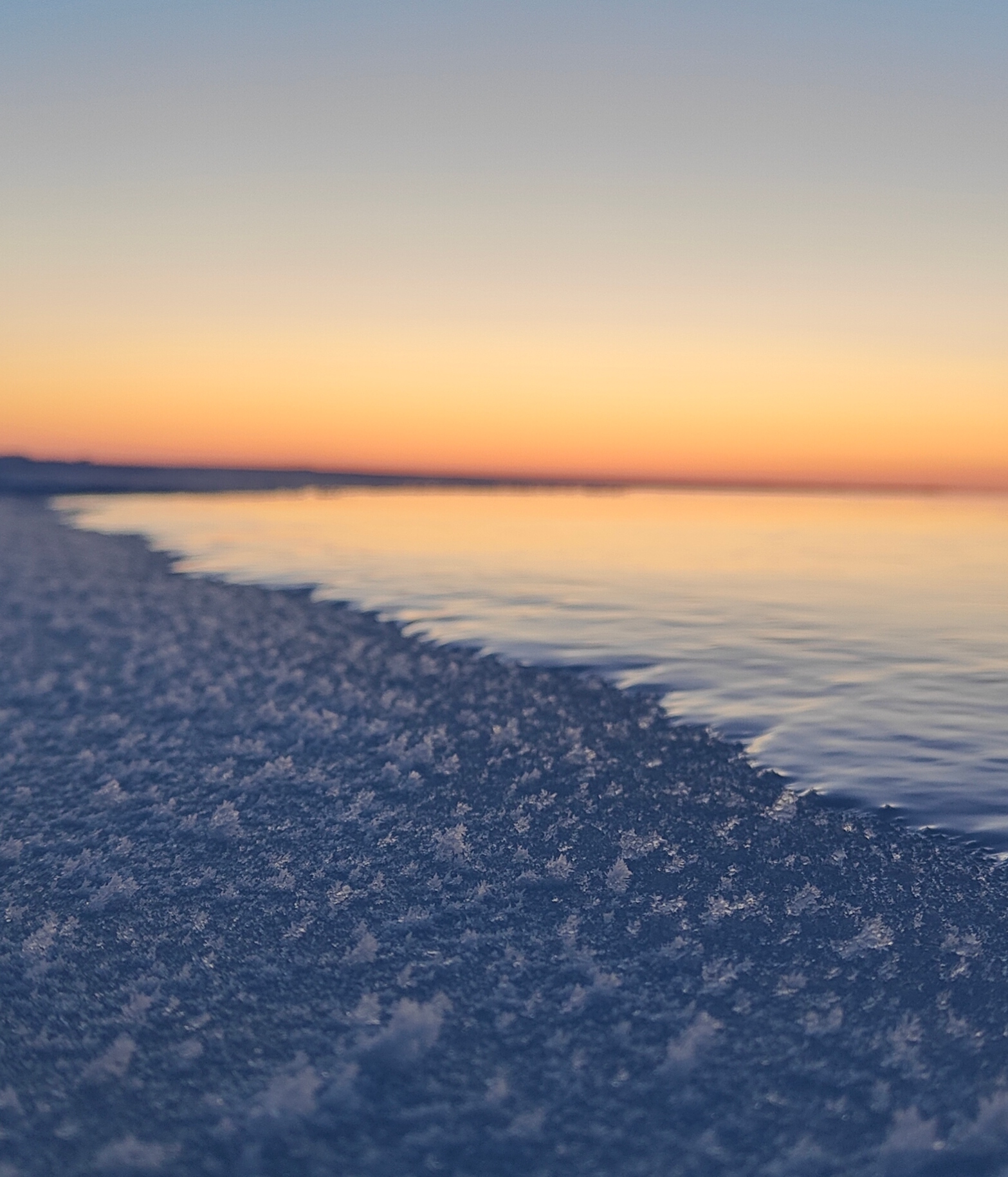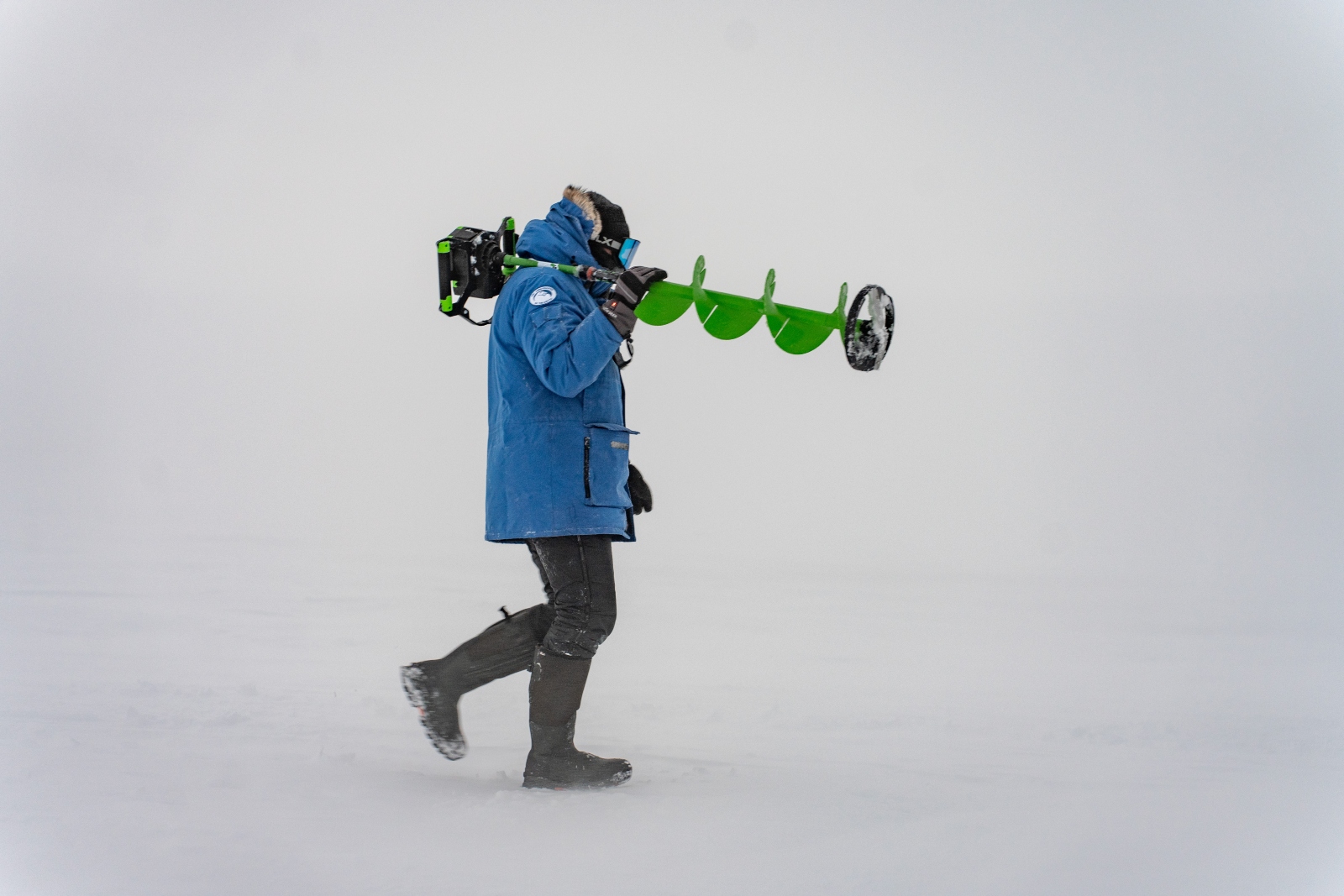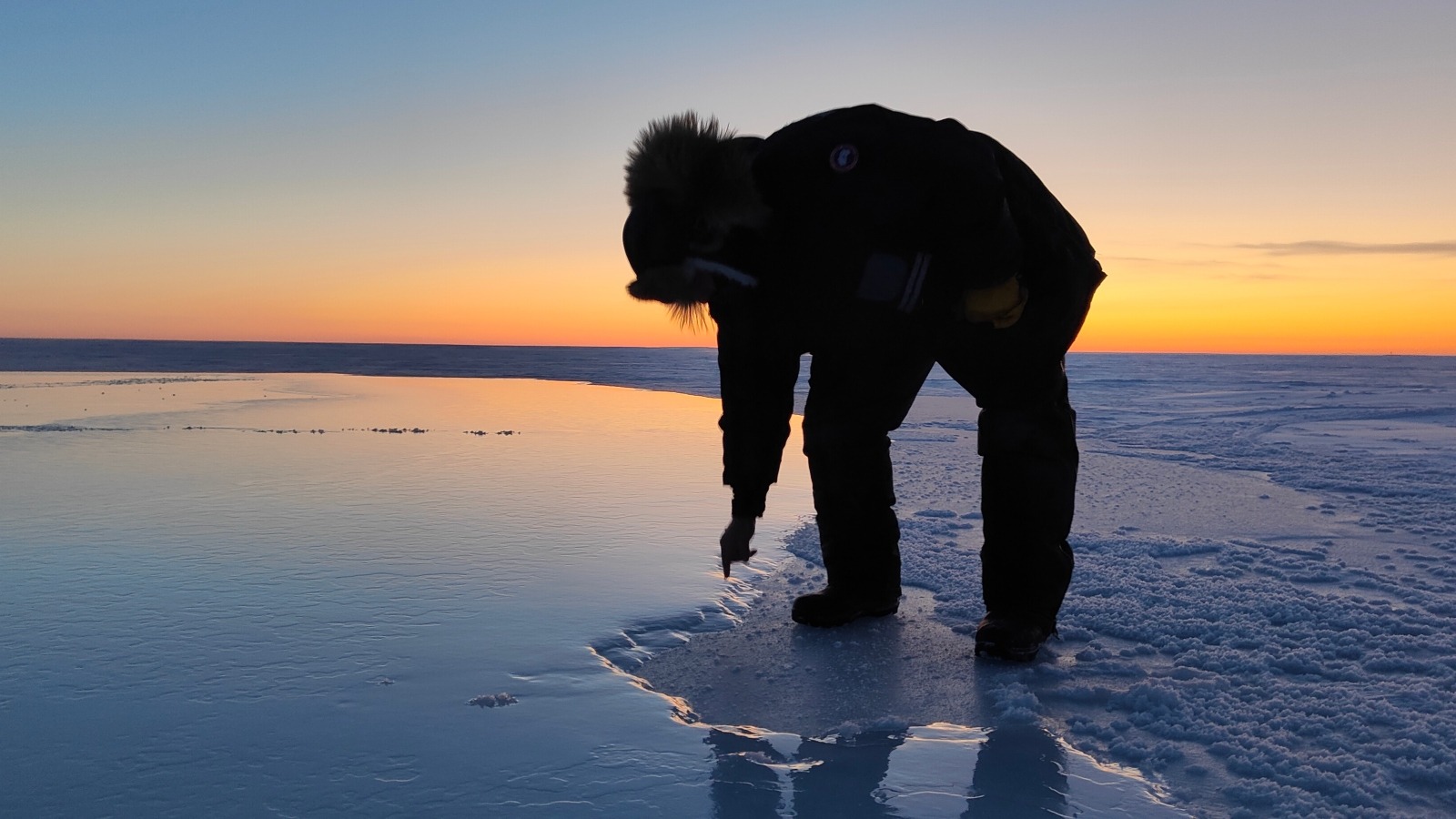In the dim twilight of an Arctic winter’s day, with the low sun stretching its orange fingers across the frozen sea, a group of researchers drill a hole through the ice and insert a hydrogen-powered pump. It looks unremarkable — a piece of pipe protruding from a metal cylinder — but it holds many hopes for protecting this landscape. Soon, it is sucking up seawater from below and spewing it onto the surface, flooding the area with a thin layer of water. Overnight this water will freeze, thickening what’s already there.
The hope is that the more robust the ice, the less likely it will be to disappear in the warm summer months.
Since 1979, when satellite records began, Arctic temperatures have risen nearly four times faster than the global average. Sea ice extent has decreased by about 40 percent, and the oldest and thickest ice has declined by a worrying 95 percent. What’s more, scientists recently estimated that as temperatures continue to climb, the Arctic’s first ice-free day could occur before 2030, in just five years’ time.
The researchers are from Real Ice, a United Kingdom-based nonprofit on a mission to preserve this dwindling landscape. Their initial work has shown that pumping just 10 inches of ocean water on top of the ice also boosts growth from the bottom, thickening it by another 20 inches. This is because the flooding process removes the insulating snow layer, enabling more water to freeze. When the process is done, the patch of ice measured up to 80 inches thick — equal to the lower range of older, multi-year ice in the Arctic. “If that is proved to be true on a larger scale, we will show that with relatively little energy we can actually make a big gain through the winter,” said Andrea Ceccolini, co-CEO of Real Ice. Ceccolini and Cian Sherwin, his partner CEO, ultimately hope to develop an underwater drone that could swim between locations, detecting the thickness of the ice, pumping up water as necessary, then refueling and moving on to the next spot.
This winter, they carried out their largest field test yet: comparing the impact of eight pumps across nearly half a square mile off the coast of Cambridge Bay, a small town in the Kitikmeot Region of Nunavut, part of the Canadian Arctic. They now wait until June for the results.
Their work is at the heart of a debate about how we mitigate the damage caused by global warming, and whether climate interventions such as this will cause more harm than good.
Loss of sea ice has consequences far beyond the Arctic. Today, the vast white expanse of this ice reflects 80 percent of the sun’s energy back into space. Without it, the dark open ocean will absorb this heat, further warming the planet. According to the Scripps Institution of Oceanography at the University of California, San Diego, if our sea ice disappears entirely, it will add the equivalent warming of 25 years of carbon dioxide emissions. There are also huge implications for our weather patterns: Diminishing sea ice is already changing ocean currents, increasing storms, and sending warmer, drier air to California, causing increased wildfires. Within the Arctic, loss of ice means loss of habitat and food security for the animals, microorganisms, and Indigenous communities that depend on it.
“Personally I’m terrified,” said Talia Maksagak, Executive Director of the Kitikmeot Chamber of Commerce, about the changing sea ice. It’s freezing later and thinner each year, affecting her community’s ability to travel between islands. “People go missing, people are travelling and they fall through the ice,” she continues. They also rely on the ice for hunting, fishing, and harvests of wild caribou or musk ox, who migrate across the frozen ocean twice a year — although they, too, are increasingly falling through the thin ice and drowning.
Maksagak has been instrumental in helping Real Ice to consult with the local community about their research, and she is supportive of their work. “If Real Ice comes up with this genius plan to continue the ice freeze longer, I think that would be very beneficial for future generations.”

There are still many questions around the feasibility of Real Ice’s plan, both for critics and the Real Ice researchers themselves. First, they need to establish if the principle works scientifically — that the ice they’ve thickened does last longer, counteracting the speed of global warming’s impact on the region. At worst, adding salty seawater could potentially cause the ice to melt more quickly in the summer. But results from last year’s research suggest not: When testing its pilot ice three months later, Real Ice found its salinity was within normal bounds.
If all goes well with this year’s tests, the next step will be an independent environmental risk assessment. Noise is one concern. According to WWF, industrial underwater noise significantly alters the behaviour of marine mammals, especially whales. Similarly, blue cod lay their eggs under the ice, algae grows on it, and larger mammals and birds migrate across it. How will they be impacted by Real Ice’s water pumps? “These are all questions that we need to ask,” said Shaun Fitzgerald, Director of the Center for Climate Repair at Cambridge University, which has partnered with Real Ice, “and they all need to be addressed before we can start evaluating whether or not we think this is a good idea.”
Fitzgerald predicts four more years of research are needed before the nonprofit can properly recommend the technology. For now, the Nunavut Impact Review Board, Nunavut’s environmental assessment agency, has deemed Real Ice’s research sites to cause no significant impact.

But critics of the idea argue the process won’t scale. “The numbers just don’t stack up,” said Martin Siegert, a British glaciologist and former co-chair of the Grantham Institute for Climate Change. He pointed to the size of the Arctic — 3.9 million square miles of sea ice on average — and how many pumps would likely be needed to freeze even 10 percent of that. More importantly, who is going to pay for it?
Ceccolini is undaunted by the first question. Their technology is not complicated — “it’s technology from 50 years ago, we just need to assemble it in a new way” — and would cost an estimated $5,000 per autonomous pump. Their models predict that 500,000 pumps could rethicken about 386,000 square miles of sea ice each year, or an area half the size of Alaska. Assuming the thicker ice lasts several years, and by targeting different areas annually, Ceccolini estimates the technology could maintain the current summer sea ice levels of around 1.63 million square miles. “We’ve done much bigger things in humanity, much more complex than this,” he said.
As for who pays, that’s less clear. One idea is a global fund similar to what’s been proposed for tropical rainforests, where if a resource is globally beneficial, like the Amazon or the Arctic, then an international community contributes to its protection. Another idea is ‘cooling credits’, where organizations can pay for a certain amount of ice to be frozen as an offset against global warming. These are a controversial idea started by the California-based, geoengineering start-up Make Sunsets, which believes that stratospheric aerosol injections — releasing reflective particles high into the earth’s atmosphere — is another way to cool the planet. However its research comes with many risks and unknowns that has the scientific community worried, and has even been banned in Mexico. Meanwhile faith in the credits system has been undermined in recent years, with several investigations revealing a lack of integrity in the carbon credits industry.

Panganga Pungowiyi, climate geoengineering organizer for the Indigenous Environmental Network, a nonprofit for environmental and economic justice issues, is vehemently against cooling and carbon credits in principle, explaining that they are “totally against our [Indigenous] value system.” She explained that, “it’s essentially helping the fossil fuel industry escape accountability and cause harm in other Indigenous communities — more pain, more lung disease, more cancer.”
This gets to the heart of the debate — not whether a solution like this can be done, but whether it should be done. Inuit opinion is divided. Whilst Maksagak is supportive of Real Ice, Pungowiyi says the technology doesn’t align with Indigenous values, and is concerned about the potential harms of scaling it. In addition to the environmental concerns, Pungowiyi notes that new infrastructure in the Arctic has historically also brought outsiders, often men, and an increase of physical and sexual assault on Indigenous women, many who end up missing or murdered. Ceccolini and Sherwin are aware of such risks and they are clear that any scaling of their technology would be done in partnership with the local community. They hope the project will eventually be Indigenous-run.

“We don’t want to repeat the kind of mistakes that have been made by Western researchers and organizations in the past,” said Sherwin.
Real Ice is not the only company that wants to protect the Arctic. Arctic Reflections, a Dutch company, is conducting similar ice thickening research in Svalbard; the Arctic Ice Project is assessing if glass beads spread over the ice can increase its reflectivity and protect it from melting; and engineer Hugh Hunt’s Marine Cloud Brightening initiative aims to increase the reflectivity of clouds through sprayed particles of sea salt as a way to protect the ice.
“I think these ideas are getting far too much prominence in relation to their credibility and maturity,” said Seigert, referring to conversations about Arctic preservation at annual United Nations climate change meetings, known as COP, and the World Economic Forum. It is not only that these technologies are currently unproven, Seigert noted, but that people are already making policy decisions based on their success. It’s an argument known as ‘moral hazard’ — the idea that developing climate engineering technologies will reduce people’s desire to cut emissions. “This is like a gift to the fossil fuel companies,” he said, allowing them to continue using oil, gas, and coal without change. “We have the way forward, decarbonization, and we need every effort to make that happen. Any distraction away from that is a problem.”

“It’s a strong argument,” agreed Fitzgerald, of Cambridge University, when asked about moral hazard. “I am concerned about it. It’s the one thing that probably does cause me to have sleepless nights. However, we need to look at the lesser of two evils, the risk of not doing this research.”
Or as Sherwin said: “What is the cost of inaction?”
Those in support of climate intervention strategies stress that although decarbonization is vital it’s moving too slowly, and there is a lack of political will. Technologies like those being developed by Real Ice could buy ourselves more time. Paul Beckwith, a climate system analyst from the University of Ottawa, espouts a three-pronged approach: eliminating fossil fuels, removing carbon dioxide from the atmosphere, and protecting the Arctic.
“It should be less a conversation of one over the other and more how we run all three pillars at the same time,” said Sherwin. “Unfortunately we’re in a position now where if we don’t protect and restore ecosystems, we will face collapse.”
Source link
Matilda Hay grist.org


